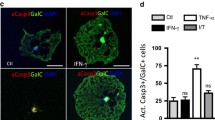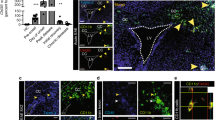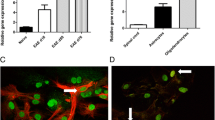Summary
Oligodendrocytes are myelin-forming cells in the mammalian central nervous system. About 50% of oligodendrocytes undergo cell death in normal development. In addition, massive oligodendrocyte cell death has been observed in multiple sclerosis. Tumor necrosis factor (TNF) is thought to be one of the mediators responsible for the damage of oligodendrocytes in multiple sclerosis. The addition of TNF-α to primary cultures of oligodendrocytes significantly decreased the number of live cells in 72 h. DNA fragmentation was detected in TNF-treated oligodendrocytes at 36 h by TUNEL assay. Chemical inhibitors Ac-YVAD-CHO (a specific inhibitor of caspase-1 [ICE]-like proteases) as well as Ac-DEVDCHO (a specific inhibitor of caspase-3[CPP32]-like proteases) enhanced the survival of oligodendrocytes treated with TNF-α, indicating that caspase-1- and the caspase-3-mediated cell-death pathways are activated in TNF-induced oligodendrocyte cell death. Caspase-11 is involved in activation of caspase-1. Oligodendrocytes fromCASP-11-deficient mice are partially resistant to TNF-induced oligodendrocyte cell death. Our results suggest that the inhibition of caspases may be a novel approach to treat multiple sclerosis.
Similar content being viewed by others
References
Alnemri ES, Livingston DJ, Nicholson DW, Salvesen G, Thornberry NA, Wong WW, Yuan J (1996) Human ICE/CED-3 protease nomenclature. Cell 87: 171
Boldin MP, Mett IL, Verfolomeev EE, Chumakov I, Shemer-Avni Y, Camonis JH, Wallach D (1995) Self-association of the “death domains” of the p55 tumor necrosis factor (TNF) receptor and Fas/APO1 prompts signaling for TNF and Fas/APO1 effects. J Biol Chem 270: 387–391
Boldin MP, Goncharov TM, Goltsev YV, Wallach D (1996) Involvement of MACH, a novel MORT1/FADD-interacting protease, in Fas/APO-1- and TNF receptor-induced cell death. Cell 85: 803–815
Chinnaiyan AM, Tepper GG, Seldin MF, O'Rourke K, Kischkel FC, Hellbardt S, Krammer PH, Peter ME, Dixit VM (1996) FADD/MORT1 is a common mediator of CD95 (Fas/APO-1) and tumor necrosis factor receptor-induced apoptosis. J Biol Chem 271: 4961–4965
Dolle RE, Hoyer D, Prasad CV, Schmidt SJ, Helaszek CT, Miller RE, Ator MA (1994) P1 aspartate-based peptide α-([2,6-dichlorobenzoyl]oxy)methyl ketones as potent time-dependent inhibitors of interleukin-1β-converting enzyme. J Med Chem 37: 563–564
Dopp JM, Makenzie-Graham A, Otero GC, Merrill JE (1997) Differential expression, cytokine modulation, and specific functions of type-1 and type-2 tumor necrosis factor receptors in rat glia. J Neuroimmunol 75: 104–112
Dowling P, Husar W, Menonna J, Donnenfeld H, Cook S, Sidhu M (1997) Cell death and birth in multiple sclerosis brain. J Neurol Sci 149: 1–11
D'Souza S, Alinauskas K, McCrea E, Goodyer C, Antel JP (1995) Differential susceptibility of human CNS-derived cel populations to TNF-dependent and independent immune-mediated injury. J Neurosci 15: 7293–7300
Genain CP, Roberts T, Davis RL, Nguyen MH, Uccelli A, Faulds D, Li Y, Hedgpeth J, Hauser SL (1995) Prevention of autoimmune demyelination in non-human primates by a cAMP-specific phosphodiesterase inhibitor. Proc Natl Acad Sci USA 92: 3601–3605
Hisahara S, Shoji S, Okano H, Miura M (1997) ICE/CED-3 family executes oligodendrocyte apoptosis by tumor necrosis factor. J Neurochem 69: 10–20
Hsu H, Xiong J, Goeddel DV (1995) The TNF receptor 1-associated protein TRADD signals cell death and NF-κB activation. Cell 81: 495–504
—, Shu HB, Pan MG, Goeddel DV (1996) TRADD-TRAF2 and TRADD-FADD interactions define two distinct TNF receptor 1 signal transduction pathways. Cell 84: 299–308
Itoh N, Nagata S (1993) A novel protein domain required for apoptosis: mutational analysis of human Fas antigen. I Biol Chem 268: 10932–10937
Medema JP, Scaffidi C, Kischkel FC, Shevchenko A, Mann M, Krammer PH, Peter ME (1997) FLICE is activated by association with the CD95 death-inducing signaling complex (DISC). EMBO J 16: 2794–2804
Miura M, Zhu H, Rotello R (1993) Induction of apoptosis in fibroblasts by IL-1β-converting enzyme, a mammalian homolog of theC. elegans cell death geneced-3. Cell 75: 653–660
—, Friedlander RM, Yuan J (1995) Tumor necrosis factor-induced apoptosis is mediated by a CrmA-sensitive cell death pathway. Proc Natl Acad Sci USA 92: 8318–8322
Muzio M, Chinnaiyan AM, Kischkel FC, O'Rourke K, Shevchenko A, Ni J, Scaffidi C, Bretz JD, Zhang M, Gentz R, Mann M, Krammer PH, Peter ME, Dixit VM (1996) Flice, a novel FADD-homologous ICE/CED-3-like protease, is recruited to the CD95 (Fas/APO-1) death-inducing signaling complex. Cell 85: 817–827
Pender MP, Nguyen KB, McCombe PA, Kerr JFR (1991) Apoptosis in the nervous system in experimental allergic encephotomyelitis. J Neurol Sci 104: 81–87
Probert L, Akassoglou K, Pasparakis M, Kontogeordos G, Kollias G (1995) Spontaneous inflammatory demyelinating disease in transgenic mice showing central nervous system-specific expression of tumor necrosis factor alpha. Proc Natl Acad Sci USA 92: 11294–11298
Ray CA, Black RA, Kronheim SR, Greenstreet TA, Sleath PR, Salvesen GS, Pickup DJ (1992) Viral inhibition of inflammation: cowpox virus encodes an inhibitor of the interleukin-1 β converting enzyme. Cell 69: 597–604
Selmaj KW, Raine CS (1988) Tumor necrosis factor mediates myelin and oligodendrocyte damage in vitro. Ann Neurol 23: 339–346
— —, Canella B, Brosnan C (1991) Identification of lymphotoxin and tumor necrosis factor in multiple sclerosis lesions. J Clin Inv 87: 949–954
Tartaglia LA, Ayres TM, Wong GH, Goeddel DV (1993) A novel domain within the 55 kd TNF receptor signals cell death. Cell 74: 845–853
Tewari M, Dixit VM (1995) Fas- and tumor necrosis factor-induced apoptosis is inhibited by the poxvirus crmA gene product. J Biol Chem 270: 3255–3260
Wang S, Miura M, Jung YK, Zhu H, Gagliardini V, Shi L, Greenberg AH, Yuan J (1996) Identification and characterization of Ich-3, a member of the interleukin-1 β converting enzyme (ICE)/Ced-3 family and an upstream regulator of ICE. J Biol Chem 271: 20580–20587
— — — —, Li E, Yuan J (1998) Murine caspase-11, an ICE-interacting protease, is essential for the activation of ICE. Cell 92: 501–509
Author information
Authors and Affiliations
Rights and permissions
About this article
Cite this article
Miura, M., Hisahara, S., Takano, R. et al. Involvement of caspases in cytotoxic cytokine-mediated oligodendrocyte cell death. Protoplasma 206, 219–223 (1999). https://doi.org/10.1007/BF01288207
Received:
Accepted:
Issue Date:
DOI: https://doi.org/10.1007/BF01288207




